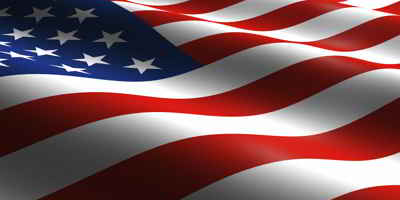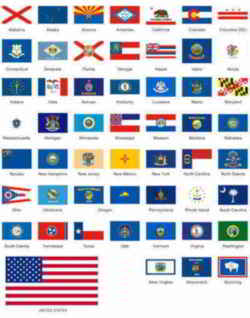

Florida Symbols
Florida State Flag
Adopted in 1900.
The state flag of Florida was adopted in 1900. Reminiscent of Alabama's State Flag and the red "X" of the Confederate States of America, the Florida State Flag consists of a red saltire, St. Andrew's Cross, on a white background, with the state seal superimposed on the center. The design was approved by a popular referendum in 1900. The current design has been in use since 1985, after the state seal was graphically improved and officially sanctioned for use by state officials.
The Florida State Flag
Florida Flag of 1900
A joint resolution of the legislature in 1899, approved by state voters in 1900, made the current State Flag the official banner of Florida. The Department of State is the custodian of the State Flag.
Between 1868 and 1900, Florida's state flag consisted of a white field with the state seal in the center. During the late 1890s, Governor Francis P. Fleming suggested that a red cross be added, so that the banner did not appear to be a white flag of truce or surrender when hanging still on a flagpole.
Many flags have flown over Florida since Juan Ponce de Le? landed in 1513. Among them have been the flags of five sovereign nations: Spain, France, Great Britain, the United States, and the Confederate States of America. Numerous other unofficial flags also have been flown on the peninsula at one time or another. Only a written description remains of some of these banners.
Flag Chronology
- Spanish Discovery 1513

Spain did not have a national flag when Juan Ponce de Le? first set foot on the shores of Florida in 1513. At the time, the Spanish royal banner was the colorful flag of Castile and Le?. This flag has become popularly associated with early Spanish exploration of the Americas, although it is not known whether this banner actually was carried ashore in Florida by Ponce de Le?
- French Attempts at Settlement 1564

The French established a short-lived settlement, in 1564, near Jacksonville at the mouth of the St. Johns River. During this period there was no single official flag for France. Their flag may have had a blue field which bore the royal golden fleurs-de-lys. The French also occupied Pensacola from 1719 to 1722 during the War of the Quadruple Alliance.
- First Spanish Occupation 1565 - 1763

The Burgundian saltire, or Cross of Burgundy, represented Spanish rule in Florida from 1565 to 1763. The X-shaped cross symbolized the rough branches of the trees on which Saint Andrew, the patron saint of Burgundy, was crucified. The flag was introduced into Spain by Philip I, Duke of Burgundy, and was later established as one of the country's banners by his son Charles1 I, in 1516.
- British Occupation 1763-1784

The red Cross of St. George, the patron saint of England, was the major element of the British flag. In combination with the white Scottish Cross of St. Andrew, it formed the Union flag. This flag flew over Florida from 1763 until 1784.
- Second Spanish Occupation 1784-1821

Charles III created this Spanish national flag in 1785. It flew over Florida until the United States took official posession of the territory in 1821.
- State of Muskogee 1799-1803

English adventurer William Augustus Bowles designed this flag after a congress of Creeks and Seminoles elected him director general of the State of Muskogee in 1799. The capital of this state was the Indian village of Miccosukee (near present day Tallahassee). Bowles was captured, turned over to Spanish authorities in 1803, and later died in a Havana prison. The State of Muskogee came to an end.
- Republic of West Florida 1810

This flag flew over the Free and Independent State of West Florida from September 23 to December 6, 1810. This state covered the area below the thirty-first parallel between the Mississippi and Pearl Rivers--now a part of Louisiana. The flag later became the unofficial ensign of the South in 1860-61 and inspired Harry McCarthy to compose the well-known song, "The Bonnie Blue Flag."
- Patriots Flag 1812

As Spanish power was declining in Florida, a group of seventy Georgians and nine Floridians crossed the St. Marys River to Amelia Island on March 13, 1812, to establish the "Territory of East Florida." They read a manifesto and raised a flag with the Latin inscription, "Salus populi lex suprema," or "The safety of the people, the supreme law." President James Madison refused to acknowledge their claim, and the movement failed.
- Green Cross Flag 1817

In 1817 American citizens, desiring the independence of Florida, sponsored an expedition into the Spanish-territory led by Gregor MacGregor, a veteran of Latin American revolutions. The group occupied Amelia Island on June 20 and raised a white flag with a green cross. Four months later they were forced to leave, and their flag was all but forgotten.
- The 27th State July 4, 1845

The United States government admitted Florida as the twenty-seventh state on March 3, 1845. By law, new stars were added to the national flag on the fourth of July following the admission of each new state, so a twenty-seventh star was added for Florida on July 4, 1845.
- Proposed State Flag 1845

On March 3, 1845, Florida became the twenty-seventh state. Citizens of Tallahassee presented incoming Governor William D. Moseley with a flag that flew at his inauguration. However, because of a controversy surrounding its motto, it never became an official state flag. The flag shown here is reconstructed from a written description.
- Florida Secession Banner 1861

Unofficial "secession" flags were flying in many parts of the state even before Florida left the Union. "The Ladies of Broward's Neck" in Duval County presented this flag to Governor Madison Starke Perry. It was displayed at the Capitol when the Ordinance of Secession was signed on January 11, 1861.
- Florida's First Official Flag 1861

After Florida seceded from the Union in January 1861, a number of unofficial flags flew over the state. The general assembly passed an act directing Governor Madison S. Perry to adopt "an appropriate device for a State flag which shall be distinctive in character." Six months later the governor had the secretary of state record the description of Florida's first official flag. Whether it was ever raised over the Capitol or in the field is unknown. The flag shown here is reconstructed from a written description.
- Second Official State Flag 1868-1900

The Constitutional Convention of 1868 provided Florida with its second official state flag. It declared that the legislature should, as soon as convenient, "adopt a State Emblem having the design of the Great Seal of the State impressed upon a white ground of six feet six inches fly and six feet deep."
Florida Flag Law
The 2006 Florida Statutes, Title 4, Chapter 15
TITLE IV. EXECUTIVE BRANCH.
CHAPTER 15. SECRETARY OF STATE.
15.012 State flag.--The state flag shall conform with standard commercial sizes and be of the following proportions and description: The seal of the state, in
diameter one-half the hoist, shall occupy the center of a white ground. Red bars, in width one-fifth the hoist, shall extend from each corner toward the center, to the outer rim of
the seal.
History.--s. 2, ch. 70-300.
15.02 Custodian of state flag; state papers; state laws and legislative documents.--The Department of State shall have custody of the
state flag; of all books, papers, files, and documents belonging to the office of Secretary of State; and of the laws of the state and books, papers, journals, and
documents of the Legislature.
History.--s. 3, ch. 1, 1845; RS 74; GS 75; RGS 89; CGL 111; s. 2, ch. 28086, 1953; ss. 10, 35, ch. 69-106.

The Flags of the US.





